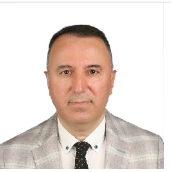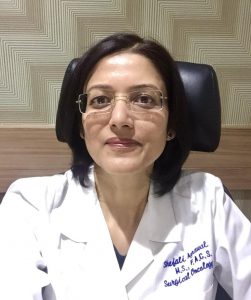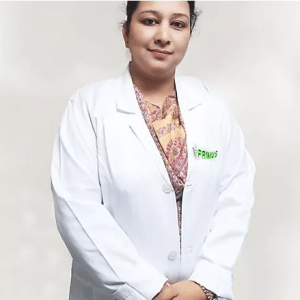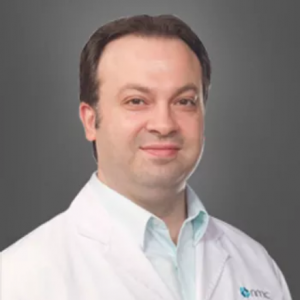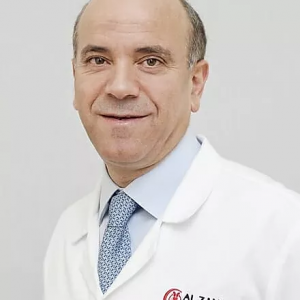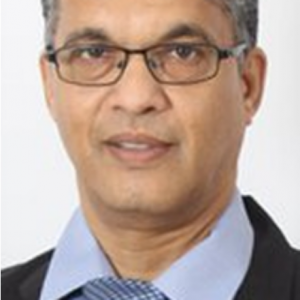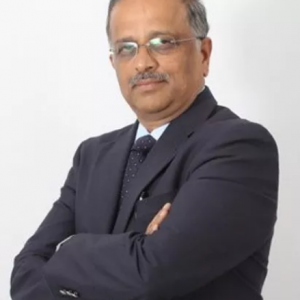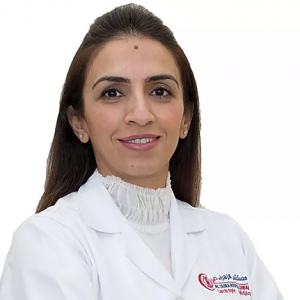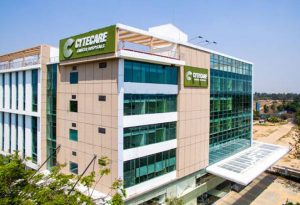Radioactive Iodine Treatment for Thyroid Cancer
Radioactive Iodine therapy has been utilized for the treatment of thyroid cancer for a long time, beginning in the 1940s. Radioactive iodine can be used for the treatment of overactive thyroid and some types of thyroid cancer. Thyroidectomy (the surgical removal of the thyroid gland) is usually enough to remove thyroid cancer from an individual. However, in cases where the cancer has spread, especially to the lymph node and other parts of the body or where the tumors are not small, additional treatment is required. Read More
Top Doctors For Radioactive Iodine Treatment for Thyroid Cancer Treatments
Top Hospitals For Radioactive Iodine Treatment for Thyroid Cancer Treatments
Radioactive Iodine Treatment for Thyroid Cancer
Table of contents
Overview
Radioactive Iodine therapy has been utilized for the treatment of thyroid cancer for a long time, beginning in the 1940s. Radioactive iodine can be used for the treatment of overactive thyroid and some types of thyroid cancer. Thyroidectomy (the surgical removal of the thyroid gland) is usually enough to remove thyroid cancer from an individual. However, in cases where the cancer has spread, especially to the lymph node and other parts of the body or where the tumors are not small, additional treatment is required.
This additional treatment is radioactive iodine therapy. Though radioactive iodine therapy is usually done as a follow-up treatment for larger and more aggressive tumors, it can also be used as an adjuvant treatment for smaller tumors when they have especially worrisome features like blood vessel invasion, are multi-focal, or are very aggressive. Radioactive iodine therapy is used at about 1 or 2 months after a papillary thyroid cancer surgery. It is done in order to kill any other cancer cells that were not removed during the surgery. Radioactive iodine is usually given in pill form, but it can also be administered in liquid form.
How does radioactive iodine treat thyroid cancer?
The radioactive iodine enters the bloodstream after ingestion and is taken up by any thyroid-like cells. The radioactivity then destroys the cancer cells, and it gives off radiation that also destroys nearby cancer cells over time. The most common forms of thyroid cancer can generally be treated with massive doses of radioactive Iodine. A tracer dose of radioactive iodine can also be used to track cancer cells that may have spread to other parts of the body.
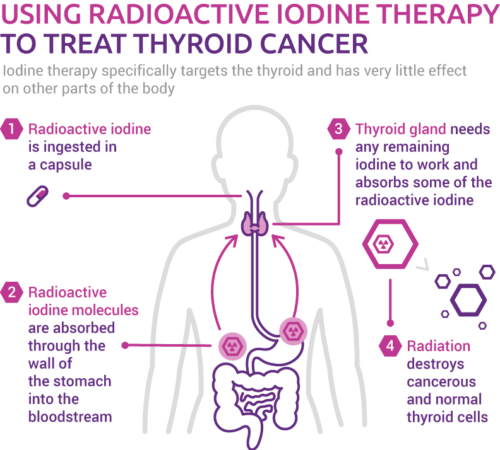
What are the side effects of radioactive iodine?
Permanent hypothyroidism is an expected side effect of the therapy. However, this is relatively easy to handle using hormone replacement therapy. Hormone replacement therapy is usually a safe, inexpensive, and reliable treatment. Some of the temporary side effects of radioactive iodine therapy may include the following:
- Mild nausea after the radioactive iodine has been taken. The doctor usually provides the patient with anti-emetics which helps to prevent this.
- Dry mouth, which is caused by damage to the salivary glands. It may occur if a higher dose of radioactive iodine is ingested. It can happen immediately after the treatment, or it may not happen for several months to a year after the treatment. Drinking plenty of liquids helps fight this phenomenon.
- Dry eyes and sometimes excessive lacrimation of the eyes may be experienced following the treatment.
- Tenderness or swelling in the cheeks, which is caused by irritation or damage to the salivary glands by the radioactive iodine. This can occur as early as the morning after the treatment and may continue for up to a year after the treatment.
- Change in taste which is caused by irritation of the taste buds. Food might take a salty or metallic taste after the treatment. This is usually temporary and may go away after eight weeks from the treatment.
- Discomfort in the neck can happen during the first 2-3 weeks after the treatment. This depends on the amount of thyroid tissue remaining in the patient’s neck. In some very rare cases, the treatment can cause swelling in the neck, which can make it hard for the patient to breathe. This is a serious condition, and the doctor should be contacted.

What to expect before the radioactive iodine therapy
The health care provider will usually discuss the treatment plan with the patient, the plan will usually follow these steps, and they usually occur over a few days:
- Blood tests are carried out on the first day. After the tests, a thyrotropin alpha injection is administered. This helps the body get ready for radioactive iodine absorption.
- Another thyrotropin alpha shot is administered on the second day, followed by a small dose of radioactive iodine for diagnostic purposes. After ingesting that dose, the patient’s body is scanned to show how the radioactive iodine is being taken by the body.
- On the third day, the full dose of the radioactive iodine is then administered. This procedure is usually an outpatient one.
- Another scan is done some days after the treatment. This helps to show the doctor where the dose of radioactive iodine has been taken up.
A low-iodine diet is usually followed for about a week before the start of the therapy. The low-iodine diet will ensure the effectiveness of the radioactive iodine therapy. Too much iodine in the diet can inhibit the thyroid cells from taking up the radioactive iodine. This diet is also continued 24 hours after the treatment is completed and as advised by the health care provider.
Precautions to take for the therapy
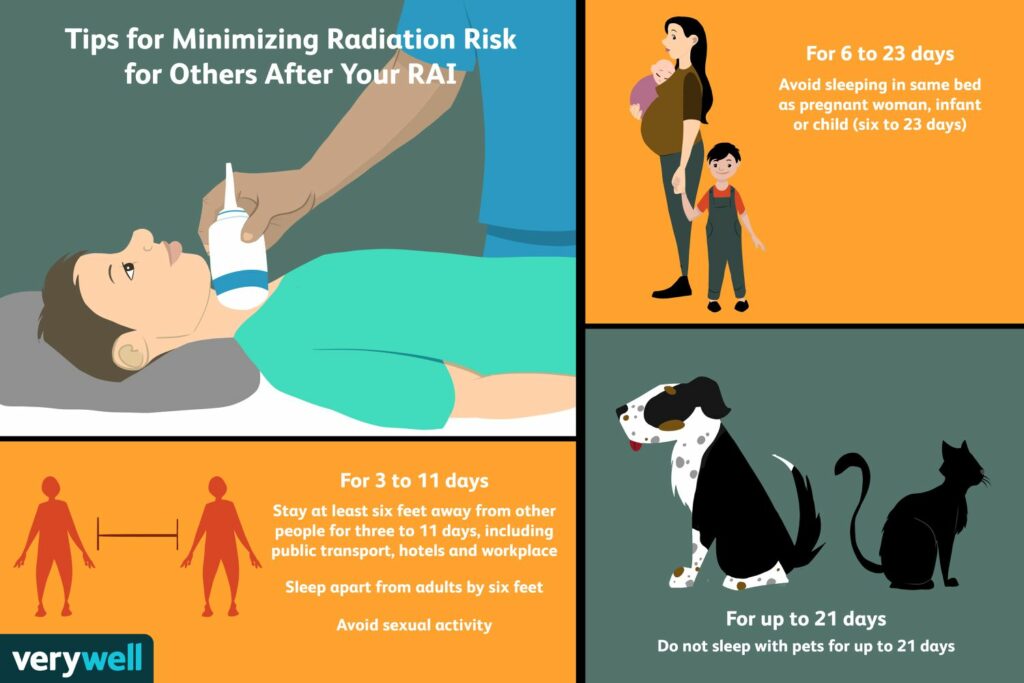
Some of the essential precautions that must be observed for individuals that are undergoing radioactive iodine therapy include:
- Pregnant women should not receive radioactive iodine therapy.
- Patients that have undergone radioactive iodine therapy should not get pregnant for at least six months after the therapy or for as long as advised by the doctor.
- As radioactive iodine can collect in the breast tissue with milk in it, breastfeeding is not advised for at least 6-12 weeks before the treatment. Also, breastfeeding is not done after the treatment because it can expose the baby to radiation.
- In the days following the therapy, a general precaution is to be taken to prevent radioactive exposure to other people. The healthcare provider gives specific instructions on how long to follow these precautions.
- Precautions to prevent exposure of others to radiation are – to avoid prolonged physical contact with others, especially children and pregnant women. Stay at least 6 feet away from others and avoid public places. Sleep alone in a separate bed at least 6 feet away from others. Wash hands as often as possible. Have separate household items, do dishwashing, laundering items separately from others. Do not share personal items, bedding, towels, kitchen and cooking utensils with others.








